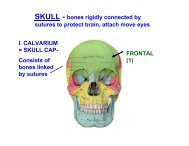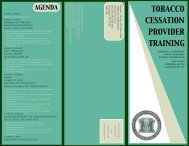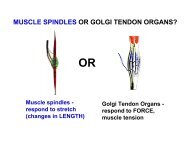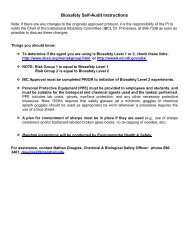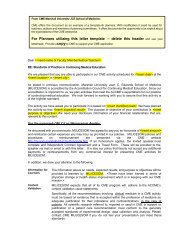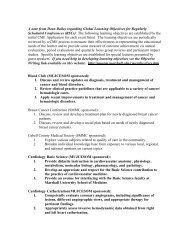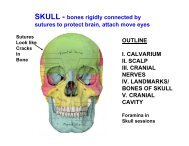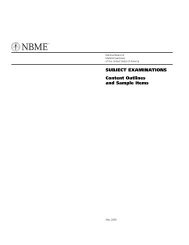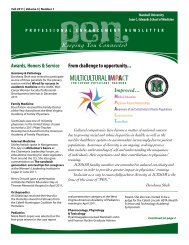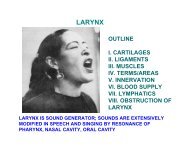FA 5 Progress Report WV-INBRE - Joan C. Edwards School of ...
FA 5 Progress Report WV-INBRE - Joan C. Edwards School of ...
FA 5 Progress Report WV-INBRE - Joan C. Edwards School of ...
- No tags were found...
Create successful ePaper yourself
Turn your PDF publications into a flip-book with our unique Google optimized e-Paper software.
Program Director/Principal Investigator (Last, First, Middle): Rankin, Gary O 32to adipokines. Given that the AHR is a ligand-activated transcription factor, we hypothesize thatAHR regulation <strong>of</strong> gene expression determines the maximal level <strong>of</strong> cancer cell growth that canoccur in response to adipokines. The objectives <strong>of</strong> this proposal are to define the genome-wide set<strong>of</strong> cis elements bound by the AHR (the AHR cistrome) in the human MCF-7 breast cancer cell lineto further investigate how the AHR controls cancer growth by regulating gene expression.b) Methods & Results: Chromatin immunoprecipitation coupled with next generation sequencing(ChIP-Seq) was used to define the AHR cistrome in MCF-7 cells. AHR-ChIP-Seq was performedwith chromatin isolated from MCF-7 cells treated with DMSO (vehicle) or the AHR agonist 2,3,7,8tetrachlorodibenzo-p-dioxin (TCDD). With total chromatin input controls, Model-based Analysis <strong>of</strong>ChIP-Seq (MACS) was performed to generate peaks <strong>of</strong> sequence tag enrichment to identifyspecific AHR DNA binding site. Using MACS and peak finding, we identified the binding <strong>of</strong> the AHRto a region upstream from the CYP1B1 gene known to contain 5 AHR binding GCGTC motifs (thespecific peak region identified by MACS was ~650 to 1100 bp upstream from the CYP1B1transcription start site). In TCDD treated MCF-7 cells, this peak had a false discovery rate (FDR)<strong>of</strong> less than 1.5 % with an AHR binding motif within 13 bp <strong>of</strong> the peak summit (area <strong>of</strong> highestsequence build up, and predicted to the precise AHR binding site). The CYP1B1 promoter spanningpeak in DMSO treated MCF-7 cells had a FDR <strong>of</strong> less than 4.5% and an AHR binding sequencemotif within 57 bp <strong>of</strong> the peak summit. Using MACS we also identified the AHR binding to theCYP1A1 gene promoter in regions containing AHR binding motifs with FDRs ranging from less 3%to less than 6 %. Thus, with MACS we have identified AHR binding to known AHR binding motifsthat have been shown to have transcriptional activity. Conventional AHR-ChIP confirmed recruitment<strong>of</strong> AHR to CYP1A1 and CYP1B1 gene promoters, providing further validation <strong>of</strong> our AHR-ChIP-Seqexperiments. With total input as a control, MACS analysis <strong>of</strong> AHR-ChIP-Seq identified ~134,000peaks in TCDD-treated MCF-7 cells and ~97,700 peaks in vehicle-treatedMCF-7 cells. Currently, we are validating additional AHR gene targets and will use bioinformatics t<strong>of</strong>urther characterize the biology <strong>of</strong> AHR binding as it pertains to cancer growth.NGS Project #6Title: Global Analysis <strong>of</strong> DNase I Hypersensitivity Sites in Treg CellsSubproject investigator: Wei-ping Zeng, PhDIntroduction: Regulatory T (Treg) cells function as active suppressors <strong>of</strong> immune responses <strong>of</strong>conventional T cells and other immune cells. They play important regulatory roles in immuneresponses to infections and cancers. Therefore, understanding the pathogenesis and designingnew therapies <strong>of</strong> infectious diseases and cancers will benefit from studies <strong>of</strong> regulation <strong>of</strong> genesimportant for Treg cell function and frequencies. In the past, many molecules expressed by Tregcells have been identified to mediate their immune suppressive function. In addition, other genesexpressed in Treg cells, including those important for homeostatic maintenance <strong>of</strong> the Treg cells,have been analyzed with gene expression arrays. However, little is known about the regulation <strong>of</strong>these genes in Treg cells. DNAse I hypersensitive (DHS) sites <strong>of</strong>ten contain important ciselements, such as locus control regions, enhancers and sometimes silencers.Methods: To study the regulation <strong>of</strong> the important genes in Treg cells, we wish to obtain a map <strong>of</strong>the global distribution <strong>of</strong> the DHS sites in Treg cells. Towards this goal, we are adapting a methodfor DNase-Seq analysis for high throughput on the Illumina next generation sequencer.Result and Discussion: Since the Treg cells are a minor population <strong>of</strong> CD4 T cells, before applyingthe method to this rare population <strong>of</strong> cells we determined the best experimental conditions usingtotal CD4 T cells. We have tried different concentrations <strong>of</strong> DNAse I, temperatures and times <strong>of</strong>digestion <strong>of</strong> the nuclei. In addition, we made several modifications to improve the yields <strong>of</strong> DNA atvarious steps. After pulling down the DNA fragments derived from ends generated by DNase IPHS 2590 (Rev. 06/09)Continuation Format Page



